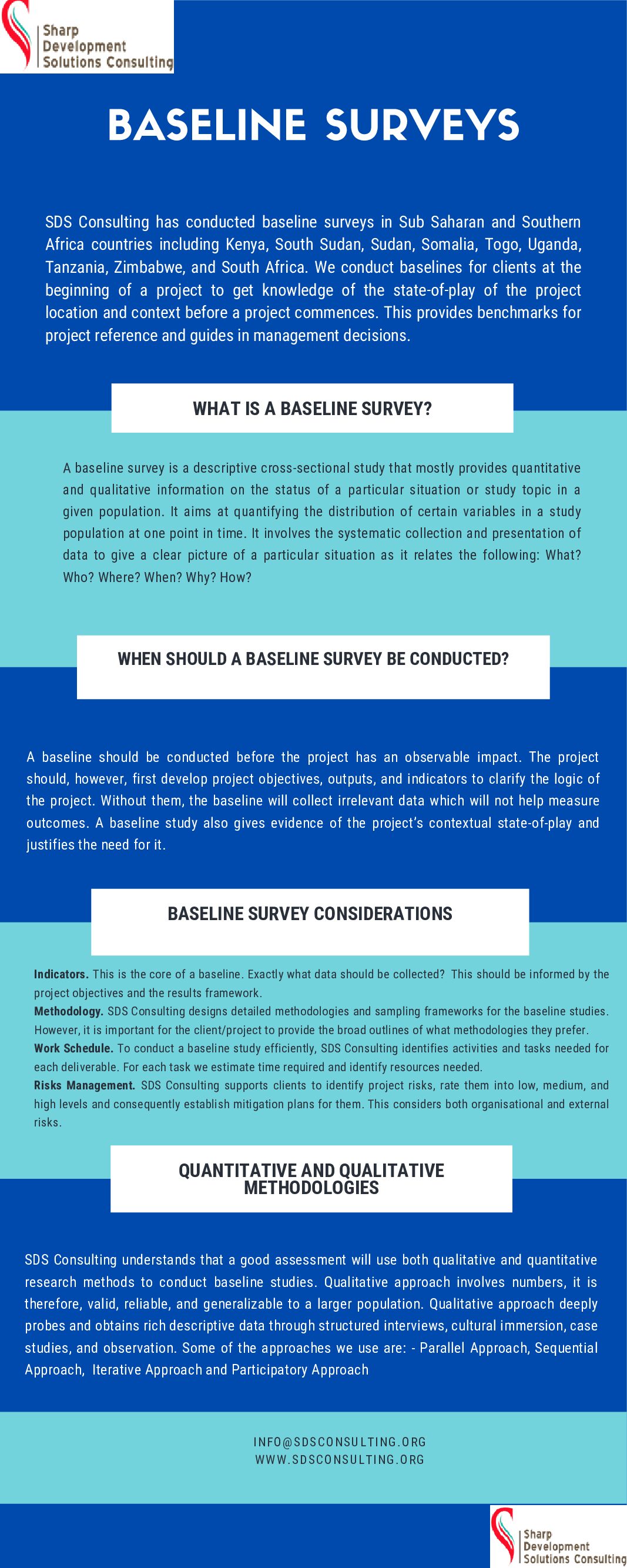A. INTRODUCTION
SDS Consulting has conducted baseline surveys in East, Horn, West and Southern Africa including Kenya, South Sudan, Sudan, Somalia, Uganda, Ethiopia, Rwanda, Togo, Nigeria, Mozambique, Egypt, Malawi, Zambia, Zimbabwe, and South Africa. We conduct baselines for clients at the beginning of a project to get knowledge of the status of an item of study before a project commences and provide benchmarks, where projects can refer to for the purposes of making project management decisions.
SDS emphasizes the importance of conducting a baseline surveys before a project commences, this will enable projects make informed decisions and access impact of the project activities at the end of a project intervention.
B. WHAT IS A BASELINE SURVEY?
A baseline study is a descriptive cross-sectional survey that mostly provides quantitative and qualitative information on the status of a particular situation or study topic in a given population. It aims at quantifying the distribution of certain variables in a study population at one point in time. It involves the systematic collection and presentation of data to give a clear picture of a particular situation as it relates the following: What? Who? Where? When? Why? How?
C. WHEN SHOULD A BASELINE SURVEY BE CONDUCTED?
A baseline should be conducted before the project has an observable impact. The project should, however, first develop project objectives outputs and indicators to clarify the logic of the project. Without them, the baseline will collect irrelevant data which will not help measure outcomes.
D. BASELINE SURVEY PLAN
The questions below should be considered when conducting a baseline survey.
What indicators are you measuring? This is the core of a baseline. Exactly what data should be collected? This should be informed by the project objectives and the purpose of the baseline.
What methodology will be used? SDS Consulting normally designs detailed methodologies and workplans. However, it is important for the client/project to provide the broad outlines of what methodologies they prefer. The project must dedicate sufficient resources to draft a clear term of reference, manage the consultant, and read and understand the final report and data.
E. QUANTITATIVE AND QUALITATIVE METHODOLOGIES
SDS Consulting is aware that a good assessment borrows from just one method, we therefore, use both qualitative and quantitative methods to conduct baseline surveys. This helps us to both quantify results and explain how this came about. Some of the approaches we use are explained below: –
i. Parallel Approach. In a parallel approach, the quantitative and qualitative assessment teams work separately but compare and combine findings during the analysis phase. When using the parallel approach, the qualitative data do not inform the design of the survey, but provide an independent alternative source of information, shedding more light on, for example, the nature and depth of the study topic as experienced by different socio-economic groups. This approach is the most practical one for large-scale projects, where closer forms of interaction between the qualitative and quantitative assessment teams may be difficult to establish and maintain due to logistical and administrative constraints.
ii. Sequential Approach. In a sequential approach, first several qualitative assessment techniques are used to generate a more in-depth understanding of a situation and to identify the issues that need to be further investigated. The findings of the qualitative assessment are then used as an input in the design of the quantitative survey. This approach is useful in complex programmes where diverse and un-anticipated impacts are likely. This is particularly so when there is less knowledge about all the factors, known and unknown, that might lead to impact.
iii. Iterative Approach. An iterative approach takes the sequential approach one step further. Following the initial qualitative assessment and subsequent quantitative assessment phase, the assessment team returns to the field to seek further clarification on unresolved questions and possible contradictions that emerge from comparing findings. This approach makes the best use of combined methods but may require more resources and time than most programmes can afford.
iv. Participatory Approach. A participatory approach is aimed to enhance the participation of local people, agencies, and decision makers in the assessment process, including the design and implementation of the assessment and the analysis of the findings. In a participatory approach, local stakeholders contribute to the definition of what constitutes “success” and take part in the identification of indicators to measure impact. It gathers local people’s views on where impact occurred, why, how and to what extent Local people can also provide clarification on the findings of a quantitative survey and may provide an input in the design of a quantitative survey in terms of the identification of areas of particular interest. Participatory methods improve the quality and reliability of the information, and they help to understand and consider social and cultural factors that are difficult to measure through a standard survey. This approach also results in more ownership and a better level of understanding of the findings among stakeholders.
Compiled by,
Wanjugu Mathenge,
Project Officer,
SDS Consulting.








